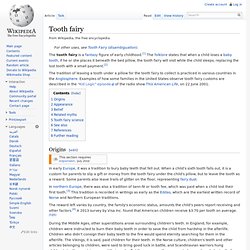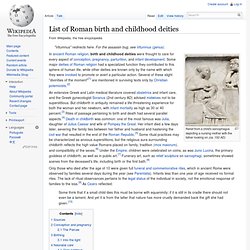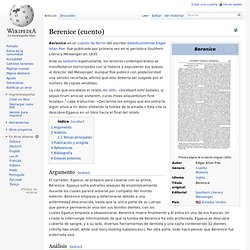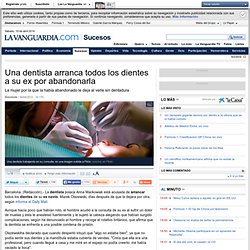

Otros genios con dientes. El hada de los dientes. Toothless (Conocida en España como El hada de los dientes y en Hispanoamérica como Un hada muy especial) es una película estadounidense para televisión producida por Mandeville Films para Walt Disney Television.

La película fue dirigida por Melanie Mayron y protagonizada por Kirstie Alley y Dale Midkiff. Argumento[editar] La dentista Katherine Lewis es una mujer atractiva pero con mal carácter.Ella es algo engreída y orgullosa,y por eso nunca se permitió enamorarse de un hombre.Su padre también era dentista y ella quiso seguir con la tradición familiar. Un día,cuando Katherine sale del trabajo,es atropellada por un ciclista y se queda inconsciente.Más tarde,Katherine se despierta y por un momento piensa que está en el cielo,pero una horrible y exigente mujer llamada oficial Rogers le dijo que en realidad estaba en el Limbo,un lugar donde deciden si enviar a las personas que han muerto al cielo o al infierno.
Elenco[editar] Tooth Fairy - Wikipedia, la enciclopedia libre. The tooth fairy is a fantasy figure of early childhood.[1] The folklore states that when a child loses a baby tooth, if he or she places it beneath the bed pillow, the tooth fairy will visit while the child sleeps, replacing the lost tooth with a small payment.[2] The tradition of leaving a tooth under a pillow for the tooth fairy to collect is practiced in various countries in the Anglosphere.

Examples of how some families in the United States observe tooth fairy customs are described in the "Kid Logic" episode of the radio show This American Life, on 22 June 2001. El Hada De Los Dientes. Escrito por Jorge Andrés Martínez.

Publicado el día 2013/07/03 at 4:54 AM. Last modified: 2014/04/13 at 10:25 PM. El hada de los dientes es un personaje mitológico del folklore de muchos pueblos, que realiza obsequios a los niños cuando éstos pierden su dentadura de leche. Tales inventos pueden provocar significativos disgustos entre los infantes cuando, al crecer, se enteran que estos simpáticos seres jamás existieron. Don’t tell the kids: The real history of the tooth fairy. There are three central figures in the pantheon of North American children’s mythology: Santa Claus, the Easter Bunny and the tooth fairy.

But while the origins of the first two are fairly well documented — a combination of Christian and pagan traditions, with some recent tweaks from the marketing departments at Coca-Cola and Cadbury, respectively — far less is known about the third. As recently as the 1970s, when a radio DJ in Chicago made an on-air reference to the tooth fairy, staff at the American Dental Association were inundated with calls for more information about her. “We went out of our minds,” the director of library services said at the time. “We should have at our fingertips answers to all dentally related questions. But in this area we have nothing.” Around the same time, a professor at nearby Northwestern University Dental School named Rosemary Wells found herself similarly baffled. So Wells decided to take on the project herself. Tooth fairy. El hada de los dientes (Castellano) La maldad es más fuerte: La verdadera historia del Hada de Los Dientes.
La leyenda del Monstruo de la Fuente de la Peña en Jaén. En el sur de Jaén, en la carretera hacia la localidad de Los Villares a poco menos de 500 metros de las ultimas casas, se encuentra el paraje de la Fuente de la Peña, de la roca mana un manantial, hoy en día es una de las fuentes de abastecimiento de agua para la ciudad. Donde desde tiempos antiguos, siempre han estado enclavados unos lavaderos públicos. Los cuales han llegado hasta nuestros días. El Espectro de la Fuente de la Peña. Cuentos infantiles - El Ratoncito Pérez - Cuentacuentos. Ratoncito Pérez - Wikipedia, la enciclopedia libre.
Statue of the Ratoncito Pérez.

The Ratoncito Pérez or Ratón Pérez (Pérez Mouse in English) is a figure popular in Spanish and Hispanic American cultures, similar to the tooth fairy, originating in Madrid in 1894. As is traditional in some English-speaking countries, when a child loses a tooth it is customary for him or her to place it under the pillow, so that Ratoncito Pérez will exchange it for a gift. The tradition is almost universal in Spanish cultures, but takes different forms in different areas.
He is known as "Ratoncito Pérez" in Spanish speaking countries, with the exception of some regions of Mexico, Peru and Chile, where he is called "el Ratón de los Dientes" (The Tooth Mouse), and in Argentina, Venezuela, Uruguay and Colombia, he is known simply as "El Ratón Pérez". Origin[edit] The young king Buby placed his tooth under the pillow, as is customary, and waited impatiently for the arrival of the mouse.
Adaptations[edit] See also[edit] References[edit] Jump up ^ "CVC. Mater Matuta - Wikipedia, la enciclopedia libre. Mother goddess seated in a wicker chair and nursing an infant, sometimes identified as Mater Matuta[citation needed] (Roman Britain, 2nd century AD) Matralia[edit]

Lista de nacimiento romano y deidades infancia - Wikipedia, la enciclopedia libre. Relief from a child's sarcophagus depicting a nursing mother with the father looking on (ca. 150 AD) In ancient Roman religion, birth and childhood deities were thought to care for every aspect of conception, pregnancy, parturition, and infant development.

Some major deities of Roman religion had a specialized function they contributed to this sphere of human life, while other deities are known only by the name with which they were invoked to promote or avert a particular action. Several of these slight "divinities of the moment"[1] are mentioned in surviving texts only by Christian polemicists.[2] Only those who died after the age of 10 were given full funeral and commemorative rites, which in ancient Rome were observed by families several days during the year (see Parentalia).
Infants less than one year of age received no formal rites. Some think that if a small child dies this must be borne with equanimity; if it is still in its cradle there should not even be a lament. Vampiro. Berenice (cuento) Berenice es un cuento de terror del escritor estadounidense Edgar Allan Poe.

Fue publicado por primera vez en el periódico Southern Literary Messenger en 1835. Ante su sadismo espeluznante, los lectores contemporáneos se manifestaron horrorizados con la historia y expusieron sus quejas al director del Messenger. Aunque Poe publicó con posterioridad una versión recortada, afirmó que sólo debería ser juzgado por el número de copias vendidas. La cita que encabeza el relato, en latín: «Dicebant mihi sodales, si sepulchrum amicae visitarem, curas meas aliquantulum fore levatas»,[1] cabe traducirse: «Decíanme los amigos que encontraría algún alivio a mi dolor visitando la tumba de la amada.» Esta cita la descubre Egaeus en un libro hacia el final del relato. El narrador, Egaeus, se prepara para casarse con su prima, Berenice. Egaeus y Berenice son personajes muy representativos o modélicos. El lado siniestro de los cuentos clasicos Parte 2 (Especial All Hallow's eve)
Una dentista arranca los dientes a su ex novio por abandonarla. Barcelona.

(Redacción).- La dentista polaca Anna Mackowiak está acusada de arrancar todos los dientes de su ex novio, Marek Olszewski, días después de que la dejara por otra, según informa el Daily Mail. Aunque hacía poco que habían roto, el hombre acudió a la consulta de su ex al sufrir un dolor de muelas y ésta le anestesió fuertemente y le sujetó la cabeza alegando que habían surgido complicaciones, según ha denunciado el hombre y recoge el rotativo británico, que afirma que la dentista se enfrenta a una posible condena de prisión.
Olszewskiha declarado que cuando despertó intuyó que "algo no estaba bien", ya que no podía sentir sus dientes y la mandíbula estaba cubierta de vendas. Creepypasta - El hada de los dientes. KALI.